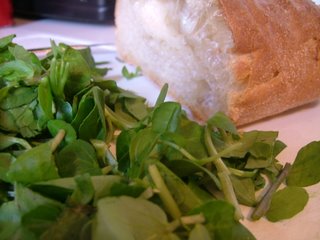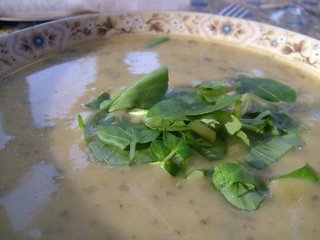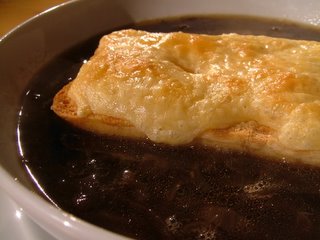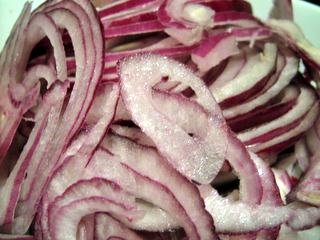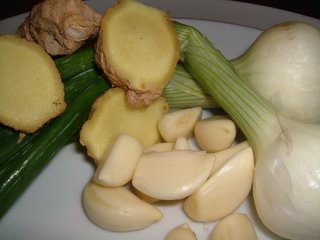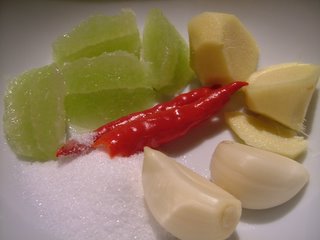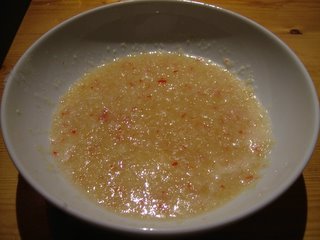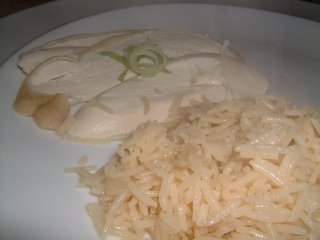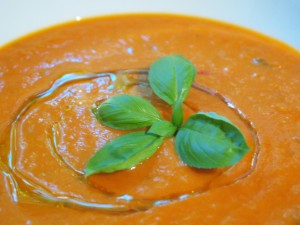 I’m looking out of the window as I type this, and I’ve come to the sad conclusion that it’s definitely not summer any more. This will be this 2010’s final recipe for the contents of your greenhouse. This year hasn’t been fantastic for tomatoes, but the cucumbers have been glorious (full disclosure here – I didn’t grow any myself, but my parents have enough to club a small army to death with), and peppers are at their best now. It goes without saying that this recipe is totally dependent on the quality of your ingredients.
I’m looking out of the window as I type this, and I’ve come to the sad conclusion that it’s definitely not summer any more. This will be this 2010’s final recipe for the contents of your greenhouse. This year hasn’t been fantastic for tomatoes, but the cucumbers have been glorious (full disclosure here – I didn’t grow any myself, but my parents have enough to club a small army to death with), and peppers are at their best now. It goes without saying that this recipe is totally dependent on the quality of your ingredients.
Most think of gazpacho as a cold tomato soup. Tomatoes do make up the dominant ingredient by weight, but a good gazpacho should take much of its flavour from the cucumber (surprisingly aromatic) and peppers. Get the finest, ripest vegetables you can find, and if at all possible, try to get your hands on one of those lovely, spurred, English cucumbers – they’ve a lot more flavour to them than one of the smooth-skinned supermarket variety. Use your best olive oil, and enjoy the last of the sunshine. If you’re preparing this as part of a special meal, you can jazz it up something spectacular by shredding some fresh, sweet white crab meat, and putting a couple of tablespoons of it in the bottom of each bowl before you pour the soup over.
Finally, a word of warning. Your guests might have a baked-in dislike of chilled soups. Check before you serve this up. I remember the look of utter misery on my Dad’s face when we visited a friend’s house once and were presented with a choice of Vichyssoise and gazpacho to open a meal with. Dad, you’re a heathen, but for you I’d warm this through on the hob.
To serve four as a starter, you’ll need:
1kg ripe tomatoes, as fresh as possible
4 banana shallots
3 cloves garlic
2 red peppers
1 green pepper
1 large cucumber
2 slices stale white bread, soaked in water and squeezed
1 teaspoon red wine vinegar
4 tablespoons olive oil
½ teaspoon smoked paprika
Salt and pepper
Peel the tomatoes by scoring them around the equator and dunking them in boiling water to loosen the skins. Cut them open and discard the seeds. Blacken the skin of the peppers under the grill, pop the steaming peppers in a plastic box with the lid on for a few minutes to loosen the skins, peel and seed. Peel the cucumber, chop the shallots into quarters and mince or otherwise squish the garlic.
Blitz the vegetables and bread to a smooth purée in batches with the other ingredients. Taste for seasoning; you may want to add a little more vinegar or paprika as well as salt. Chill thoroughly and serve cold, with a little more olive oil drizzled over.

